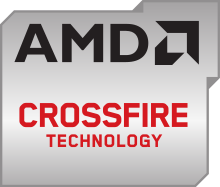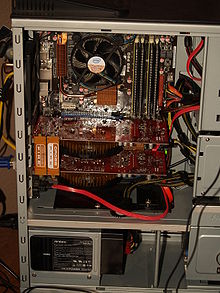
A graphics card is a computer expansion card that generates a feed of graphics output to a display device such as a monitor. Graphics cards are sometimes called discrete or dedicated graphics cards to emphasize their distinction to an integrated graphics processor on the motherboard or the central processing unit (CPU). A graphics processing unit (GPU) that performs the necessary computations is the main component in a graphics card, but the acronym "GPU" is sometimes also used to erroneously refer to the graphics card as a whole.

ATI Technologies Inc., commonly called ATI, was a Canadian semiconductor technology corporation based in Markham, Ontario, that specialized in the development of graphics processing units and chipsets. Founded in 1985, the company listed publicly in 1993 and was acquired by AMD in 2006. As a major fabrication-less or fabless semiconductor company, ATI conducted research and development in-house and outsourced the manufacturing and assembly of its products. With the decline and eventual bankruptcy of 3dfx in 2000, ATI and its chief rival Nvidia emerged as the two dominant players in the graphics processors industry, eventually forcing other manufacturers into niche roles.

A graphics processing unit (GPU) is a specialized electronic circuit initially designed to accelerate computer graphics and image processing. After their initial design, GPUs were found to be useful for non-graphic calculations involving embarrassingly parallel problems due to their parallel structure. Other non-graphical uses include the training of neural networks and cryptocurrency mining.

Radeon is a brand of computer products, including graphics processing units, random-access memory, RAM disk software, and solid-state drives, produced by Radeon Technologies Group, a division of AMD. The brand was launched in 2000 by ATI Technologies, which was acquired by AMD in 2006 for US$5.4 billion.

Scalable Link Interface (SLI) is the brand name for a now discontinued multi-GPU technology developed by Nvidia for linking two or more video cards together to produce a single output. SLI is a parallel processing algorithm for computer graphics, meant to increase the available processing power.
The Radeon Xpress 200 is a computer chipset released by ATI. The chipset supports AMD 64-bit processors as well as supporting Intel Pentium 4, Pentium D and Celeron processors. Additionally, it includes support for DDR400 RAM and DDR-2 667 RAM on the Intel Edition.
The R520 is a graphics processing unit (GPU) developed by ATI Technologies and produced by TSMC. It was the first GPU produced using a 90 nm photolithography process.
The Xpress 3200 is a revision of the Xpress 200 computer chipset released by ATI. The chipset supports AMD64 processors for Socket 939 and Socket AM2.
Chrome 20 Series is a graphics accelerator by S3 Graphics, the successor of GammaChrome S18.
AMD 580 chipset series is a computer chipset series designed by the AMD Graphics Product Group, for the AMD processors. It was designed for usage with ATI's CrossFire Multi GPU Technology, with both PCI Express slots running at x16 lanes each.
The AMD 700 chipset series is a set of chipsets designed by ATI for AMD Phenom processors to be sold under the AMD brand. Several members were launched in the end of 2007 and the first half of 2008, others launched throughout the rest of 2008.
The Evergreen series is a family of GPUs developed by Advanced Micro Devices for its Radeon line under the ATI brand name. It was employed in Radeon HD 5000 graphics card series and competed directly with Nvidia's GeForce 400 series.

Sapphire Technology Limited is a Hong Kong-based technology company, founded in 2001, which produces graphics cards for personal computers and workstations, motherboards, TV tuner cards, digital audio players and LCDTVs

AMD Hybrid Graphics technology, is a collective brand from AMD for its Radeon line of discrete and integrated GPU, promoting higher performance and productivity while saving energy consumption in GPUs.
Micro stuttering is a quality defect that manifests as irregular delays between frames rendered by a graphics processing unit (GPU). It causes the instantaneous frame rate of the longest delay to be significantly lower than the frame rate reported by benchmarking applications such as 3DMark, which usually calculate the average frame rate over a longer time interval.

The AMD 900 chipset series is identical to the AMD 800 chipset series except for the fact that it is only found on Socket AM3+ mainboards, whereas its predecessor is only found on Socket AM3 mainboards. It was released in 2011.

The Radeon 200 series is a series of graphics processors developed by AMD. These GPUs are manufactured on a 28 nm Gate-Last process through TSMC or Common Platform Alliance.
The graphics processing unit (GPU) codenamed the Radeon R600 is the foundation of the Radeon HD 2000/3000 series and the FireGL 2007 series video cards developed by ATI Technologies.
The graphics processing unit (GPU) codenamed Radeon R600 is the foundation of the Radeon HD 2000 series and the FireGL 2007 series video cards developed by ATI Technologies. The HD 2000 cards competed with nVidia's GeForce 8 series.















